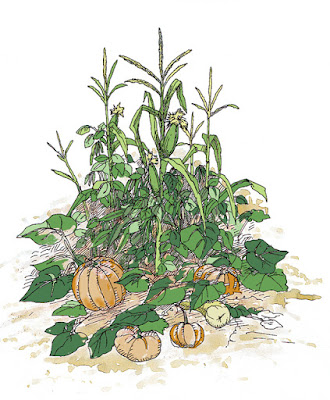The Three Sisters Garden
In horticulture The Three Sisters refers to the plants that have sustained populations for millennia: corn, beans and squash.
Grown together in one planting, it's a perfect agricultural family. The corn grows early and tall to provide support for the vining beans when they come up later. The beans create nitrogen for the soil, and the big wide squash leaves come out last after the others have sprouted in the sunshine, to shade the ground in summer, keeping moisture in and weeds out.
Eaten together, it's a complete diet of carbohydrates, proteins and vitamins. Planted together, it looked to Europeans like lazy man's farming. Where were the rows of single crops that needed hoeing and tending and weeding and work?
The Three Sisters have become an iconic symbol of the Americas. I am one of three sisters (the middle one) and there are so many ways to extend this symbolism of interdependence and sustenance to family relationships . . . . .
I heard from an old friend back east last week, and she inquired about my new gardens before going on to complain about hers -- she is endlessly pulling out poison ivy vines and getting so very tired of it.
It reminded me of the three sisters of despair in my old gardens: multiflora rose / oriental bittersweet / poison ivy.
Those three sisters -- all vines -- were the opposite of the life sustaining crops that feed people. Each was a thug, not just because they are aggressive and overgrow everything else, but because of multiflora rose's thorns and density, oriental bittersweet's growth habit that literally chokes and kills the trees it grows on, and poison ivy's terrible toxins. Three nasty plants that I tried and failed to control in the woods and meadows around my Connecticut garden.
Those were the worst to try to get rid of, but everything about gardening in the northeast was about eliminating growth.
Before we moved, I too was getting worn down by constantly weeding encroaching vegetation, whether it was lawn grass that wanted to grow in my beds, goldenrod that thought my borders were too devoid of six foot tall yellow flowers, or those three troublesome vines that overtook everything.
Gardening here in the arid southwest is the complete opposite. It's about nurturing, tending and encouraging growth, not eliminating it. I don't have to weed. Nothing grows here unless I plant it, water it and take care of it.
Although there are plant and landscape challenges galore in the west, the fact that nothing grows in my garden without my bringing it into being suits my inherent need for control.
My sisters would agree I'm a control freak. They have their fine qualities too, and like a Three Sisters Garden, we have grown separately but together for six and seven decades now, successfully. I'll let you ponder who is the squash, which one is corn. and who is beans.
Grown together in one planting, it's a perfect agricultural family. The corn grows early and tall to provide support for the vining beans when they come up later. The beans create nitrogen for the soil, and the big wide squash leaves come out last after the others have sprouted in the sunshine, to shade the ground in summer, keeping moisture in and weeds out.
Eaten together, it's a complete diet of carbohydrates, proteins and vitamins. Planted together, it looked to Europeans like lazy man's farming. Where were the rows of single crops that needed hoeing and tending and weeding and work?
The Three Sisters have become an iconic symbol of the Americas. I am one of three sisters (the middle one) and there are so many ways to extend this symbolism of interdependence and sustenance to family relationships . . . . .
I heard from an old friend back east last week, and she inquired about my new gardens before going on to complain about hers -- she is endlessly pulling out poison ivy vines and getting so very tired of it.
It reminded me of the three sisters of despair in my old gardens: multiflora rose / oriental bittersweet / poison ivy.
Those three sisters -- all vines -- were the opposite of the life sustaining crops that feed people. Each was a thug, not just because they are aggressive and overgrow everything else, but because of multiflora rose's thorns and density, oriental bittersweet's growth habit that literally chokes and kills the trees it grows on, and poison ivy's terrible toxins. Three nasty plants that I tried and failed to control in the woods and meadows around my Connecticut garden.
 |
| Toxic poison ivy, strangling oriental bittersweet, and dense, thorny multiflora rose |
Those were the worst to try to get rid of, but everything about gardening in the northeast was about eliminating growth.
Before we moved, I too was getting worn down by constantly weeding encroaching vegetation, whether it was lawn grass that wanted to grow in my beds, goldenrod that thought my borders were too devoid of six foot tall yellow flowers, or those three troublesome vines that overtook everything.
Gardening here in the arid southwest is the complete opposite. It's about nurturing, tending and encouraging growth, not eliminating it. I don't have to weed. Nothing grows here unless I plant it, water it and take care of it.
Although there are plant and landscape challenges galore in the west, the fact that nothing grows in my garden without my bringing it into being suits my inherent need for control.
My sisters would agree I'm a control freak. They have their fine qualities too, and like a Three Sisters Garden, we have grown separately but together for six and seven decades now, successfully. I'll let you ponder who is the squash, which one is corn. and who is beans.


Comments